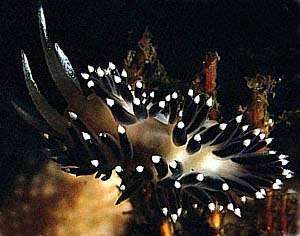
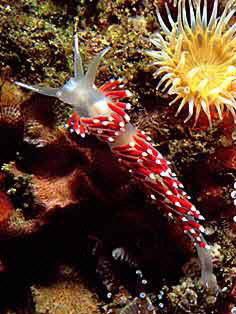
Flabellina browni
Picton, 1980
Order: NUDIBRANCHIA
Suborder: AEOLIDINA
Family: Flabellinidae
DISTRIBUTION
Known from Britain, Ireland and parts of France.
PHOTO
UPPER: approx. 25mm long, on rock at 8 metres on the east coast of Scotland. LOWER: Inisbofin, Ireland, approx 3 cm long, depth 12m, May 1999.
PHOTOS: Jim Anderson. See Scottish Nudibranchs website.
May grow to 50mm. There is a white streak down the dorsal midline from the last cerata to the posterior tip of the foot, and both the wrinkled rhinophores and long oral tentacles are streaked with white. The digetsive gland can range in colour from red to dark brown or black. There is a broad white subterminal band on each ceras. Has long been confused with Flabellina gracilis and Flabellina verrucosa. Feeds on the gymnoblastic hydroid Tubularia. See Bernard Picton's website for further information.
Reference:
• Thompson, T.E. & Brown, G.H. (1984) Biology of Opisthobranch Molluscs, Vol 2. Ray Society: London.
Rudman, W.B., 1999 (September 16) Flabellina browni Picton, 1980. [In] Sea Slug Forum. Australian Museum, Sydney. Available from http://www.seaslugforum.net/find/flabbrow
Related messages
Flabellina browni from Devon, southwest Britain
June 30, 2006
From: Louise Bailey
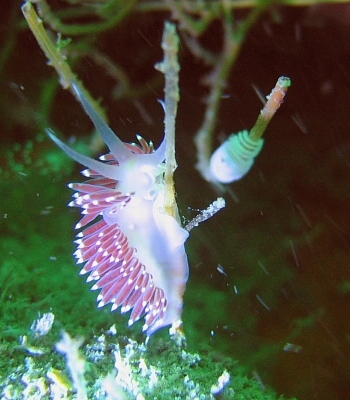
Dear Bill
This series of photographs was taken at the mouth of the Salcombe Estuary in Devon, southwestern Great Britain. It was on some scattered wreckage (the wreck of the Soudan) at a depth of approximately 20m. The wreckage was heavily covered in Tubularia hydroids, and there were very many specimens of this nudibranch in a range of sizes from approx 12 mm to 24 mm.
There was much evidence of spawn and spawn coils can be seen in the photograph. My confusion over ID lies with the fact that there are obviously many lookalikes and I can't find reference to this type so far south in the UK?
Locality: Salcombe , 20 metres, Devon, Great Britain, Atlantic Ocean, 14 June 2006, Steel wreckage on a white sandy bottom. Tidal location. Estuary mouth.. Length: 20 mm. Photographer: Caroline Hutton.
Best regards
Louise
louise@thegirls.plus.com
Bailey, L., 2006 (Jun 30) Flabellina browni from Devon, southwest Britain. [Message in] Sea Slug Forum. Australian Museum, Sydney. Available from http://www.seaslugforum.net/find/17017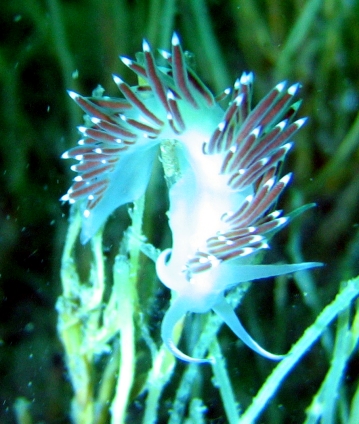
Dear Louise,
There are certainly a few look-alikes in this genus, and you really need to know the shape and colour of the head and its various tentacles, the colour of the cerata, and the presence, if any, of coloured (or white) lines on the body. My guess is that this is Flabellina browni, which is one of the Tubularia-feeding species.
Best wishes,
Bill Rudman
Re: Cuthona gymnota? from Cork, Ireland
June 23, 2006
From: Jim Anderson
Concerning message #16843:
Could we be looking at Flabellina browni?
Regards,
Jim A
jander4454@gmail.com
Anderson, J., 2006 (Jun 23) Re: Cuthona gymnota? from Cork, Ireland. [Message in] Sea Slug Forum. Australian Museum, Sydney. Available from http://www.seaslugforum.net/find/16934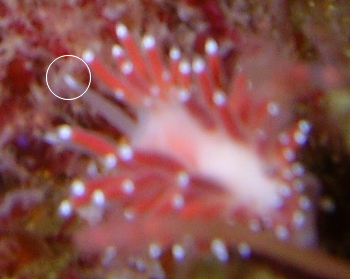
Dear Jim,
Very good idea. Actually I wondered about F. browni when I was preparing Marina's message [#16892], but like the other species of Flabellina I mentioned earlier, I was lost without some more information on rhinophore shape and colour. However on getting your message I decided to have a hunt through Jamie's photos to see if I had missed anything vital. Luckily I found white marks on the posterior tips of the rhinophores of one specimen which fits F. browni..
So I think if we add that to the general colour and shape, and Tubularia food, we can be fairly confident in identifying it as F. browni.
Best wishes,
Bill Rudman
Flabellina browni from Guernsey
July 15, 2003
From: Richard Lord
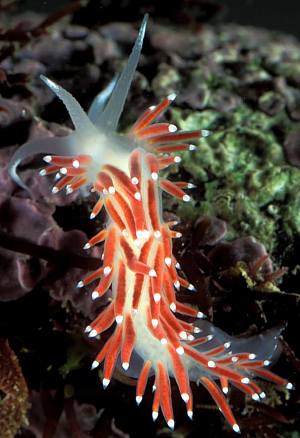
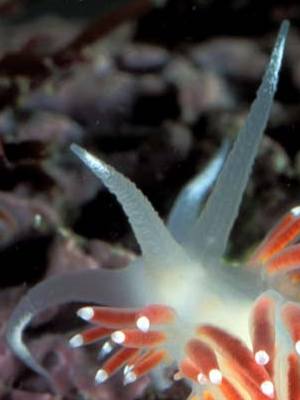
Dear Bill:
Here is a photo of Flabellina browni from Guernsey. As with previous photos, this animal was collected by crab potter Clive Brown who works strings of crab pots along Guernsey's south coast (Channel Ids, English Channel, Great Britain (about 49 24 N and 002 38 W)).
Best Wishes,
Richard
fishinfo@guernsey.net
Lord, R., 2003 (Jul 15) Flabellina browni from Guernsey. [Message in] Sea Slug Forum. Australian Museum, Sydney. Available from http://www.seaslugforum.net/find/10437Thanks Richard,
The close-up shows the slightly wrinkled rhinophores rather well
Best wishes,
Bill Rudman
Flabellina browni from the Baltic Sea
August 31, 2001
From: Erwin Köhler
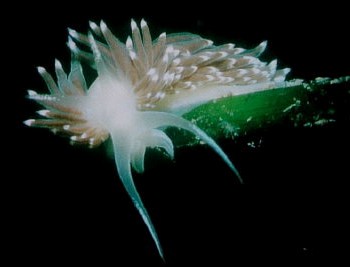
Dear Bill,
attached is a photo from the Baltic Sea, Denmark, Als Island, depth 4 m, length 8 - 10 cm (!), August 2000. It was taken by Fred Vogt. [reticulata@gmx.net].
There are so many similar looking species, so I would like to read the comment of a specialist.
Erwin
Erwin@medslugs.de
Köhler, E., 2001 (Aug 31) Flabellina browni from the Baltic Sea. [Message in] Sea Slug Forum. Australian Museum, Sydney. Available from http://www.seaslugforum.net/find/5135Dear Bill & Erwin,
I think this is Flabellina browni - on the basis of the distribution of the white pigment on the oral tentacles and rhinophores plus overall proportions. It is difficult to be certain from this one photograph though as I can't see the arrangement of the cerata clearly or the white pigment on the cerata clearly enough.
Bernard Picton
bernard.picton.um@nics.gov.uk
NB: Erwin I assume the length should be 8-10mm? .. Bill Rudman
Picton, B.E., 2001 (Aug 31). Comment on Flabellina browni from the Baltic Sea by Erwin Köhler. [Message in] Sea Slug Forum. Australian Museum, Sydney. Available from http://www.seaslugforum.net/find/5135Flabellina verrucosa from Ireland is F. browni
January 9, 2001
From: Bernard Picton
Hi Bill,
No, the photo is Coryphella browni, ceratal arrangement is subtly different and the white bands on the cerata are broader. Coryphella verrucosa has a restricted distribution in Ireland, only found on the Irish Sea coastline and the North Coast, entirely within Northern Ireland and not in the Republic. There is a zoogeographic boundary in this region, roughly Malin Head on th North Coast and the entrance to the Irish Sea at the south. C. verrucosa does occur on the Isle of Man.
Bernard
bernard.picton.um@nics.gov.uk
Picton, B., 2001 (Jan 9) Flabellina verrucosa from Ireland is F. browni. [Message in] Sea Slug Forum. Australian Museum, Sydney. Available from http://www.seaslugforum.net/find/3497Thanks Bernard,
Some of these aren't so easy from single photos. I wondered about Flabellina browni but don't know your fauna well enough to see the subtleties.
Best wishes,
Bill Rudman
Flabellina verrucosa from Ireland
January 4, 2001
From: Erwin Koehler

Dear Bill,
This one is from Ireland, Inisbofin, size about 3 cm, depth 12 m, May 15, 1999. It was taken by Jim Anderson
Email: JAnder4454@aol.com
Erwin
Medslugs.Koehler@t-online.de
Koehler, E., 2001 (Jan 4) Flabellina verrucosa from Ireland. [Message in] Sea Slug Forum. Australian Museum, Sydney. Available from http://www.seaslugforum.net/find/3442Dear Erwin,
Although I can't see the white median line on the posterior part of the foot I am pretty sure that this is Flabellina verrucosa but would of course welcome a confirmation from a colleague in Europe please.
Best wishes,
Bill Rudman
Note added 9 Jan 2001: See Bernard Picton's message identifying this as F. browni.
Rudman, W.B., 2001 (Jan 4). Comment on Flabellina verrucosa from Ireland by Erwin Koehler. [Message in] Sea Slug Forum. Australian Museum, Sydney. Available from http://www.seaslugforum.net/find/3442Re: unidentified Scottish nudibranchs (1)
September 17, 1999
From: Bernard Picton
Just had a look at Jim Anderson's unidentified aeolids and I'm sure the lower one is certainly Coryphella, my best guess is Coryphella browni, based on the broad bands on the tips of the cerata. I have seen the digestive gland go to brown and dark green in a number of Coryphella species, indeed Coryphella gracilis has a synonym smaragdina, based on this colour form.
Bernard Picton
bernard.picton.um@nics.gov.uk
Picton, B., 1999 (Sep 17) Re: unidentified Scottish nudibranchs (1). [Message in] Sea Slug Forum. Australian Museum, Sydney. Available from http://www.seaslugforum.net/find/1345Thanks Bernard,
I've split your message in two. I have put the other half on a page for Eubranchus farrani.
Bill Rudman.
